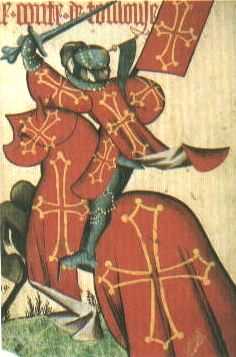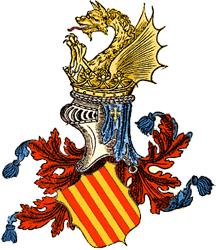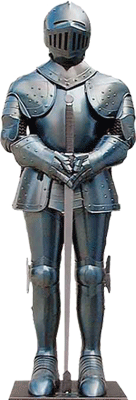
![]() The
period of the Roman Catholic Church's wars against the Cathars
of the Languedoc occured during the High Middle Ages - the
period we most naturally associate with medieval warfare.
It is a period of the classic knight, complete with lance,
shield, sword and armour. It is a time of sophisticated
castle building and military techniques, many of them learned
from the Byzantines and the Moslems during recent Crusades
to the Holy Land. Heraldry had just become established,
and many of the earliest known coats of arms (technically,
acheivements of arms) date from this period and indeed from
these wars.
The
period of the Roman Catholic Church's wars against the Cathars
of the Languedoc occured during the High Middle Ages - the
period we most naturally associate with medieval warfare.
It is a period of the classic knight, complete with lance,
shield, sword and armour. It is a time of sophisticated
castle building and military techniques, many of them learned
from the Byzantines and the Moslems during recent Crusades
to the Holy Land. Heraldry had just become established,
and many of the earliest known coats of arms (technically,
acheivements of arms) date from this period and indeed from
these wars.

![]() Contrary
to popular myth, there is little courtliness or curtesy
to be found among the Crusaders, but there is everything
else: pitched battles, armed knights, caparisoned war horses,
sieges, massacres, treachery, divided loyalties, propaganda,
acts of the wickedness and acts of heroism.
Contrary
to popular myth, there is little courtliness or curtesy
to be found among the Crusaders, but there is everything
else: pitched battles, armed knights, caparisoned war horses,
sieges, massacres, treachery, divided loyalties, propaganda,
acts of the wickedness and acts of heroism.
We are fortunate to have a number of chronicles - mainly one-sided, but nevertheless full of colour and detail.
Open battles were rare during the Cathar wars, but one spectabular example took place at Muret in 1213. More common were sieges, as at Beziers (1209), Carcassonne (1209 & 1240), Lavaur (1210), Termes (1210), Lastours (Cabaret, 1210) and Toulouse (1217-18), sometimes successful; sometimes not.
|
We have details of infantry, cavalry and artillary, including stone throwing machines (perriers), such as trebuchets and mangonels. We have details such as how Simon IV de Montfort died, hit on the head by a massive stone fired from a trebuchet operated by the women of Toulouse. Again, we know of how tactics were changed, for example at Termes where the Crusaders' perriers were redeployed to destroy a forward defensive position. We even have details of the artillary experts, often senior Churchment like the archdeacon of Paris, who played a decisive part in both strategy and tactics. In one particular case, we know how the Crusaders managed to get a trebuchet up a sheer cliff face at Montsegur. Wer know of specific siege equipment, such as belfries or siege towers. We have references to battering rams and to a seige engine known as a cat. (It was while defending a cat that Simon de Montfort was killed) |
|

![]() We
have an idea of the rules of war, largely through comments
made when the rules were breached - as at Lavaur when Simon
de Montfort exceeded even himself in barbarity. The place
had been defended by a Lady, assisted by her brother and
his knights. According all norms of Medieval war all of
them would have become prisoners of war when the siege ended
successfully for the attackers. But Simon had the Lord hanged,
and put the knights to the sword, then threw the Lady Geralda
down a well and hurled stones onto her until her cries could
no longer be heard. It was an act of such barbarity that
it is remembered with passion to this day - a war crime
by medieval standards as by modern ones.
We
have an idea of the rules of war, largely through comments
made when the rules were breached - as at Lavaur when Simon
de Montfort exceeded even himself in barbarity. The place
had been defended by a Lady, assisted by her brother and
his knights. According all norms of Medieval war all of
them would have become prisoners of war when the siege ended
successfully for the attackers. But Simon had the Lord hanged,
and put the knights to the sword, then threw the Lady Geralda
down a well and hurled stones onto her until her cries could
no longer be heard. It was an act of such barbarity that
it is remembered with passion to this day - a war crime
by medieval standards as by modern ones.

![]() Theological
questions often had military implications. For example the
Catholic Church decreed that Christians should not fight
on Sundays, but exceptions could always be forgiven. Again,
the Church taught that crossbows were unChristian. The objection
was that a mere footsoldier could kill men above him in
the social order, a knight's armour providing no protection
from an armour piercing quarrel. It was perfectly acceptable
to use crossbows against pagans and infidels (including
Moslems), but not against fellow Christians. It therefore
became critical as to whether the Cathars of the Languedoc
were heretical Christians, or not Christian at all. If they
were heretics then they were still Christians so crossbows
should not technically be used against them. If they were
not Christian at all, then they were fair game. In fact
the question never seems to have been definitively answered,
and crossbows were used anyway.
Theological
questions often had military implications. For example the
Catholic Church decreed that Christians should not fight
on Sundays, but exceptions could always be forgiven. Again,
the Church taught that crossbows were unChristian. The objection
was that a mere footsoldier could kill men above him in
the social order, a knight's armour providing no protection
from an armour piercing quarrel. It was perfectly acceptable
to use crossbows against pagans and infidels (including
Moslems), but not against fellow Christians. It therefore
became critical as to whether the Cathars of the Languedoc
were heretical Christians, or not Christian at all. If they
were heretics then they were still Christians so crossbows
should not technically be used against them. If they were
not Christian at all, then they were fair game. In fact
the question never seems to have been definitively answered,
and crossbows were used anyway.
We also have an insight into one of the main motivations for the Crusade, the winning of spoils, not very different from the practices related by Homer in ancient Greece over a thousand years earlier. At one end of the spectrum we have warriers stripping armour from their fallen foes, and mercenaries stripping any fallen warrier. At the other we have Simon de Monffort and Arnauld Amoury squabbling over who should have the title of Duke of Narbonne, expropriated from the defeated and dispossessed Count of Toulouse. It comes of something of a surprise to many modern Christians that many of the military commanders were senior churchmen. The brutal Arnaud Amaury, Cistercian Abbott of Citeaux, was just one of many.
Here too we have the great currents of history played out: the building of temoral power by Popes like Innocent III, the expansion of regional powers into modern countries - from a Medieval world of states like Andorra into a moden world of states like France. Medieval France more than doubled its size as a consequence of annexing land won by the Crusaders.







